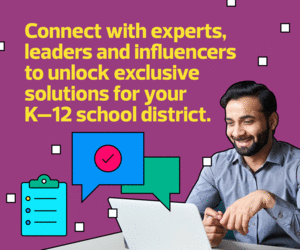Christine Pinto and Jessica Twomey, the duo behind Innovating Play, face unique challenges when it comes to integrating technology into their classrooms.
“They’re just learning their letters, and capitals usually come first. So, with lowercase letters on Chromebooks, they’re all over the place,” says Pinto, who teaches kindergarten at Arcadia Unified School District in Southern California.
“For some kids, when forming the letter is so brand new and their fine motor skills are not quite there yet, the keyboard offers them an alternative space to visualize and feel successful with that,” adds Twomey, a kindergarten teacher at Washington Township School District in New Jersey.
Pinto and Twomey work together daily to share tech in their classrooms, despite being on opposite sides of the country. The pair has figured out how to integrate tech in ways that make sense for young learners. For example, learning to find the letters they need to log in to their Chromebooks helps the kindergarten students with emergent literacy and alphabet instruction.
WATCH NOW: Pinto and Twomey discuss their partnership and tech lessons.
Both teachers are proponents of using technology as a meaningful tool, rather than a substitution for a tactile experience, and they have found myriad ways to introduce lessons on tech, critical thinking and the bigger picture.
Kindergarten Classes That Amplify Tech and Social Experiences
While Pinto’s and Twomey’s students begin the year learning things like how to log in, the lessons become progressively more advanced — for 5-year-olds — and frequently include the students’ “buddies.”
The students in Pinto’s class are paired with student buddies in Twomey’s class. They share information on their environments, such as seasonal weather, which Pinto’s Southern California students don’t experience. Around December, the students get to “meet” their buddy.
“We create a template where the children can introduce themselves by typing their name in a text box. They learn how to take a selfie and insert their picture. They learn how to insert their favorite shape and change the color of that shape. They type their age, and then they learn how to search weather words and insert images that way,” Twomey says.
The project is a culmination of the tech skills students have learned through that point in the school year. When they’re done, they have a slideshow presentation to share with the other class about themselves, and they have shown their expertise with technology in a natural setting.
Click the banner to access expert advice on tech integration in K–12 when you sign up to become an Insider.
Tech Integration Paves the Way for Kindergarteners’ Critical Thinking
The teachers say their students are constantly surprising them with how they pick up on information or make connections.
“When we come to January, lightbulbs start going on, so I start getting excited for things to click,” Pinto says. “They’re aware now that Jessica’s class is ahead of us in time. Before, when I told them, ‘They’re three hours ahead of us,’ I tried to explain that when we were asleep, they were already starting school. So now sometimes they ask, ‘What’s New Jersey doing right now?’”
The experience of working with another classroom in another part of the country gives the young students a sense of the bigger picture. From the weather updates and the time difference to the experiences of other students, technology shows the kindergarten classes that the world is larger than just the community they know.
“Our collaboration reframes the way they see and approach the world, because they have a really deep understanding that what is happening around them is only one person’s experience and one perspective, in a very different way than most 5-year-olds do, because we see outside of ourselves and outside of our space on a daily basis,” Twomey says. “I think that children learn to take in the world differently, and they learn to wonder differently, and their curiosity expands.”
Academically, the early tech integration also helps the students learn how computers operate. When one of Twomey’s students noticed that their digital days-of-school chart changed colors on days that ended in 5 or 0, it opened a conversation about data, conditional formatting, and why certain inputs lead to particular outcomes.
Twomey and Pinto then developed an activity where students filled in spreadsheet cells, and they changed color, but different colors from the cells on their days-of-school tracker. This showed the students, at a very early age, that humans teach computers what to do.
The teachers have encouraged other educators to follow their lead — they have even written a book together on integrating tech and play with learning. As the students in their kindergarten classrooms continue to learn and grow, they are going into future classes with a broader foundational understanding of technology and the world around them.











